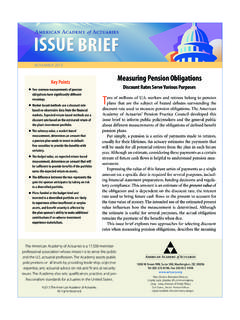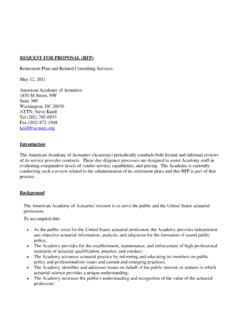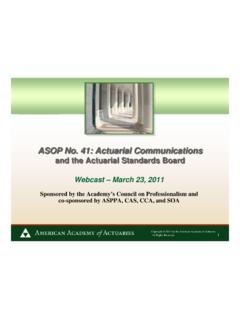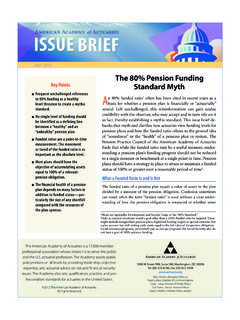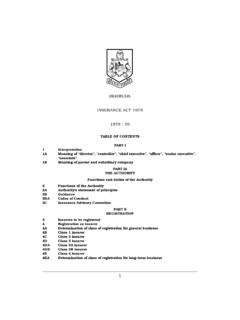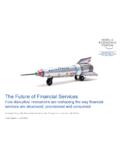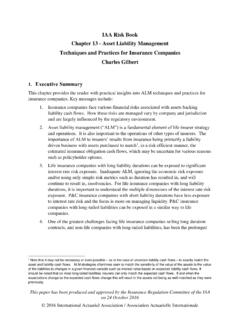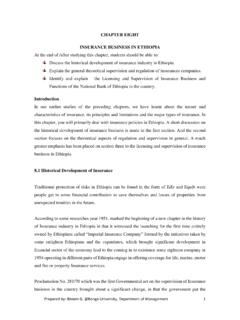Transcription of Embedded Value (EV) Reporting
1 1850 M Street NW, Suite 300 Washington, 20036202-223-8196 FAX Value (EV) ReportingA Public Policy PRAcTicE NoTEMay 2009 American Academy of ActuariesLife Financial Reporting Committee Practice Note on Embedded Value (EV) Reporting This practice note was prepared by a work group organized by the Life Financial Reporting Committee within the Life Practice Council of the American Academy of Actuaries. The practices presented here represent observations of actuaries working in the life insurance industry. This practice note is not a promulgation of the Actuarial Standards Board, is not an actuarial standard of practice, is not binding upon any actuary and is not a definitive statement as to what constitutes generally accepted practice in the area under discussion.
2 Events occurring subsequent to this publication of the practice note may make the practices described in this practice note irrelevant or obsolete. The Academy welcomes your comments and suggestions for additional questions to be addressed by this practice note. Please address all communications to Tina Getachew, Senior Risk Management and Financial Reporting Policy Analyst at The members of the Embedded Value Work group that are responsible for this practice note are: Noel Harewood, Co-Chairperson Kenneth LaSorella, Co-Chairperson Robert Frasca James Garvin Edward Jarrett Patricia Matson James Norman Jack Walton Darin Zimmerman 1 Introduction Embedded Value Reporting is growing in importance in the US and Canada.
3 Most European insurance groups (and by extension, their North American subsidiaries) are Reporting Embedded Value results publicly. In addition, the concept behind Embedded Value is similar in nature to trends in financial Reporting . The practices presented here represent observations of actuaries working for life insurance companies involved in calculating and/or reviewing Embedded Value calculations for life insurance companies in the United States and Canada. The purpose of the practice note is to assist actuaries working for life insurance companies with the calculation of Embedded values. The information contained in the practice note is not a definitive statement as to what constitutes generally accepted practice in this area.
4 Actuaries should consider the facts and circumstances specific to their situation, including the views of their independent auditors, in making a determination of appropriate practice. This practice note has been divided into six sections: Section A: Introduction to Embedded Value Section B: Mechanics of Embedded Value Section C: Assumptions Section D: Analysis of Movement Section E: Treatment of Options and Guarantees Section F Disclosure of Embedded Values 2 Section A: Introduction to Embedded Value Q1: What is Embedded Value ? A1: The CFO Forum, a discussion group composed of the CFOs of major European insurance companies, describes the Embedded Value ( EV ) of an insurance company as the consolidated Value of the shareholders interests in the company.
5 An alternative description of the Embedded Value is the present Value of all future shareholder cash flows from the covered inforce business and capital and surplus. EV does not include any values attributable to future sales. In this practice note, the term best estimate is used consistently with its use in the CFO Forum documents discussing European Embedded Value ( EEV ). In this context, the term best estimate refers to anticipated experience without provisions for adverse deviation. Q2: What is EV used for? A2: EV (or more specifically, analysis of EV) is used as a performance measurement metric. Internal uses of EV include justification for stock prices, incentive compensation of senior executives, analysis of product/line of business profitability and capital allocation.
6 External uses of EV include evaluation of mergers or acquisitions, estimates of available capital and comparison of companies across Reporting jurisdictions. External parties such as investment analysts or rating agencies might estimate the EV of a company or a business sector in order to assist in their evaluations of company performance or financial strength. Q3: What type of business is usually covered by EV? A3: EV is typically used by life insurance companies. In particular, it is used with long-term business such as life insurance and annuities. As a practical matter, certain short-term business may be excluded because the EV associated with such business may be immaterial.
7 Q4: How does EV relate to the actuarial appraisal Value of a company that is often encountered in mergers and acquisitions? A4: The actuarial appraisal method of a company is similar to EV and is calculated using similar concepts ( , discounted cash flow). However, actuarial appraisals will typically include a Value for future sales, while the EV does not. In addition, the actuarial appraisal Value will differ from EV to the extent that the assumptions entering the calculations differ. For example, actuarial appraisals are typically performed using discount rates that are higher than those used for EV because they reflect the risk premium that a buyer expects to get in acquiring a company.
8 In addition, EV assumptions typically use company-specific assumptions, whereas actuarial appraisals typically reflect a mixture of industry-wide expectations and company-specific assumptions. For example, EV is typically calculated using a 3company s specific expenses, while appraisals may use industry averages or include expected synergies. Guidance on actuarial appraisals is provided in Actuarial Standard of Practice ( ASOP ) 19 Appraisals of Casualty, Health and Life insurance Business. Q5: What information is needed in order to calculate EV? A5: In order to calculate EV, a company must have a complete inventory of its in-force policies as well as a balance sheet on the valuation date identifying assets, liabilities and capital requirements.
9 For assets, the company must have data related to asset market values. The company must also have a complete set of assumptions to calculate EV. The company uses these assumptions to project future cash flows as well as the development and release of reserves and capital . These include economic assumptions (including a discount rate, future interest rates, and variable fund performance), policyholder behavior assumptions (including lapse rates, deposit rates, and election rates), non-elective assumptions (including mortality and morbidity), as well as entity-specific assumptions for expenses and taxes. Q6: What regulations and guidance govern the calculation of EV?
10 A6: Unlike GAAP or International Financial Reporting Standards (IFRS), EV is not a prescribed accounting basis per se and, consequently, there is not a formal body of regulation that governs the calculation of EV (however, EV is dependent on the accounting basis under which the company reports its earnings and capital and surplus). Rather, practice has evolved and consolidated over time such that a set of commonly observed practices may be considered as defining elements of EV. In addition, sources of guidance have begun to develop as various industry bodies have promulgated EV principles. These serve as the key sources of practice around EV and are described below: o Achieved Profits Method (APM).
